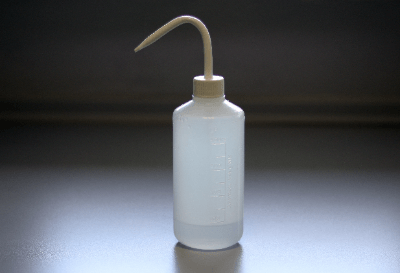What Is a Wash Bottle?

A wash bottle is a transparent or translucent plastic container equipped with a nozzle to dispense washing solutions.
Commonly found in laboratories within factories, research centers, and educational institutions, wash bottles facilitate the cleaning of equipment dirtied during experiments or processes with water or solvents.
The bottles contain solvents prepared in advance for immediate use, featuring a one-hand operable nozzle to ease the cleaning process.
Uses of Wash Bottles
Wash bottles are utilized for cleaning laboratory instruments with water, organic solvents, or other cleaning solutions. The nozzle design allows direct application of the solution onto instruments or dispensing onto a rag for wiping away contaminants. They can also be used to dispense precise amounts of liquid, such as filling a graduated cylinder to a specific mark.
Structure of Wash Bottles
Typically, a wash bottle consists of a polyethylene bottle and a nozzle, with a tube extending from the nozzle into the solution. Some wash bottles are made of glass to avoid plastic component elution in sensitive applications.
Other Information on Wash Bottles
1. How to Use a Wash Bottle
To operate, squeeze the bottle to eject liquid through the nozzle. The design allows for easy one-handed use, essential during experiments or cleaning tasks. Releasing the grip permits air to re-enter the bottle through the nozzle, readying it for subsequent use.
2. Suitable Cleaning Liquids
Commonly used cleaning solutions include ion-exchanged or distilled water, and solvents like methanol, ethanol, acetone, and isopropanol. Solvents such as toluene should be used briefly to avoid affecting the polyethylene bottle.
3. Color Coding
Color codes on wash bottles aid in identifying the contained solvent. Standard color labels include blue for water, white for ethanol, and red for acetone, though colors may vary by manufacturer.
4. Printed Labeling
Some wash bottles come pre-labeled with the solvent name, enhancing identification and reducing mix-up risks. Additionally, bottles may feature a Fire Diamond, indicating health, flammability, instability, and specific hazards.
5. Leakage and Spewing due to Temperature Changes
Temperature fluctuations can increase internal pressure, causing leakage or spewing, especially with volatile organic solvents. To mitigate fire and toxicity hazards, store wash bottles away from areas with significant temperature changes and use a sealed cock to prevent leakage, opening it only when in use.